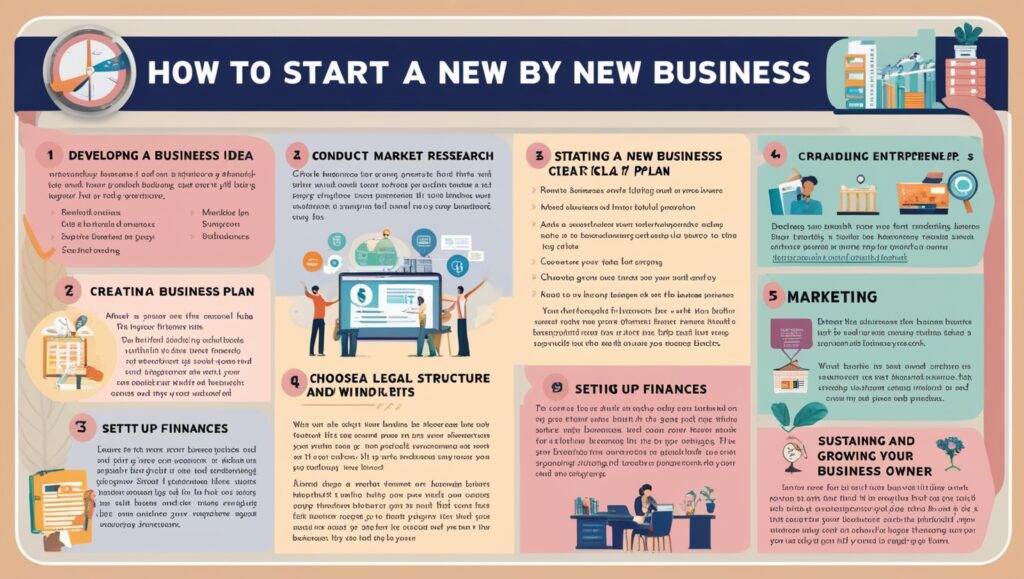How to Start Your Own Business A Step by Step Guide
Starting your own business can be one of the most rewarding and transformative experiences. However, it’s also a journey that requires careful planning, resilience, and the right approach to navigate the challenges and opportunities along the way. Here’s a step-by-step guide to help you turn your business idea into a thriving reality.
1. Develop a Business Idea and Vision
Every business begins with an idea. Start by identifying a product, service, or solution that you’re passionate about and that has a demand in the market. Think about the following:
- What unique problem does your idea solve?
- Who would benefit from your product or service?
- How is your solution different from competitors?
Tip: Make sure your idea aligns with your skills, values, and interests, as you’ll need both passion and expertise to keep pushing forward.
2. Conduct Market Research
Research is essential to understand your target market, potential competitors, and industry trends. This step provides insight into how to position your business effectively.
- Identify your target audience: Who are they? What are their needs and preferences?
- Analyze competitors: How are other companies in the industry operating? What gaps can you fill?
- Determine pricing, demand, and any barriers to entry.
Tip: Use online surveys, industry reports, and focus groups for detailed market research.
3. Write a Business Plan
A well-crafted business plan serves as a roadmap for your business. It helps you outline goals, strategies, and financial projections, making it easier to stay focused and secure funding.
- Executive Summary: Brief overview of your business and objectives.
- Market Analysis: Insights into your industry, target market, and competition.
- Products and Services: Describe what you’ll offer and why it stands out.
- Marketing Plan: Outline strategies for attracting and retaining customers.
- Financial Plan: Projected expenses, revenue, and profitability.
Tip: Keep your business plan concise yet detailed. You can refine it as your business evolves.
4. Choose a Business Structure
Your business structure determines legal responsibilities, tax obligations, and personal liability. Common structures include:
- Sole Proprietorship: You’re the sole owner and are fully responsible for debts.
- Partnership: Shared ownership and responsibilities among two or more people.
- LLC (Limited Liability Company): Provides legal protection for personal assets.
- Corporation: Separate legal entity with more complex tax requirements.
Tip: Consult with a legal professional to choose the best structure for your needs.
5. Register Your Business and Obtain Licenses
Registering your business is crucial to operate legally and protect your brand. Depending on your location and industry, you may need to:
- Register a business name or trademark.
- Apply for a business license or permit.
- Obtain an Employer Identification Number (EIN) from the IRS.
Tip: Check your local and federal regulations to ensure compliance with all legal requirements.
6. Set Up Your Finances
Proper financial management is critical for success. Open a business bank account to separate personal and business expenses. Additionally:
- Set up accounting software to track expenses, income, and cash flow.
- Create a budget that outlines all potential costs.
- Explore funding options if needed, such as small business loans, grants, or investors.
Tip: Consider hiring an accountant or using bookkeeping software to keep your finances organized.
7. Build Your Brand and Online Presence
Your brand is how customers perceive you. From your logo and website to your social media presence, building a professional image can help attract and retain clients.
- Create a logo and brand identity: Develop a memorable, cohesive look.
- Build a website: A well-designed, user-friendly website adds credibility.
- Engage on social media: Build a following by sharing valuable content and engaging with your audience.
Tip: Use tools like Canva for branding materials and Squarespace or WordPress for building your website.
8. Develop a Marketing Strategy
Marketing is key to getting your product or service in front of potential customers. Effective marketing strategies include:
- Content Marketing: Share valuable information through blogs, videos, or infographics.
- Social Media Marketing: Utilize platforms where your audience is active.
- Email Marketing: Build a list of subscribers and send targeted messages.
- SEO and PPC Advertising: Boost visibility on search engines through organic or paid ads.
Tip: Experiment with different strategies, and track results to find what resonates best with your target audience.
9. Launch Your Business
With everything in place, you’re ready to launch! Whether you’re hosting an opening event, starting online, or offering a promotional discount, the launch phase is all about making a splash.
- Announce your launch on social media and through email.
- Consider reaching out to local media or influencers for added exposure.
- Prepare to manage inquiries, process orders, and handle customer service smoothly.
Tip: Be prepared for an initial learning curve. Each launch offers valuable insights to refine your operations.
10. Gather Feedback and Adjust as Needed
After your launch, seek feedback from customers and use it to improve your offerings. Regularly review performance, track customer satisfaction, and make adjustments based on feedback.
- Conduct customer surveys to gain insights into their experiences.
- Track key performance indicators (KPIs) like sales, conversion rates, and customer retention.
- Stay updated with industry trends to keep your business competitive.
Tip: Flexibility and adaptability are essential. Don’t hesitate to pivot or improve based on market demands.
Final Thoughts
Starting a business is a journey filled with challenges, learning opportunities, and achievements. By taking it one step at a time, staying organized, and keeping your vision in mind, you can build a successful venture that aligns with your goals and passions. With the right planning and a proactive mindset, you’re ready to turn your business dream into a thriving reality.

